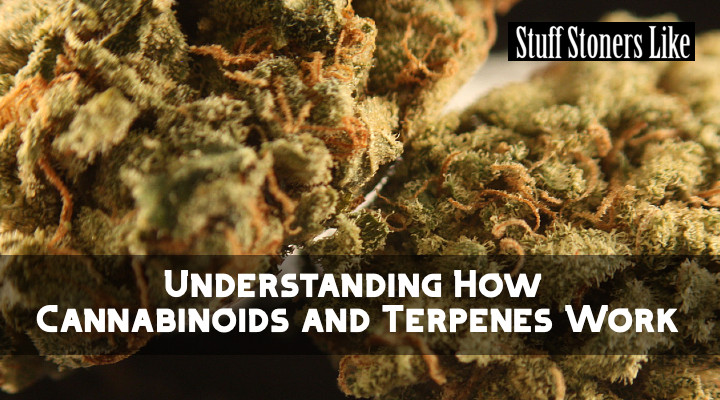
Do you ever wonder what gives CBD hemp its beneficial effects? This article explains how CBD oil and hemp flower’s therapeutic properties work. You’ll learn about the naturally occurring molecular compounds in CBD-rich hemp and how they interact with the body.
Hemp Flower Compounds
Hemp has a beautifully robust genetic character with the ability to express countless different types of compounds, including CBD and THC (cannabidiol and delta-9 tetrahydrocannabinol), which you’ve probably heard of by now. These three-lettered acronyms represent phytocannabinoids, the primary compounds in hemp, Phyto- meaning plant, and cannabinoid being derived from cannabis Sativa or hemp.
Phytocannabinoids are the main molecular compounds in hemp and there are over 120+ different types. But they are not the only compounds found in hemp with beneficial properties. Specialized compounds responsible for hemp’s unique aromas and scents, called terpenes, also play an important role in the overall effects of hemp.
There are dozens of different terpenes in hemp and each type, or strain, of hemp, has a specific terpene expression, which can be thought of as a strain’s “fingerprint”. Similar to phytocannabinoids, each terpene has particular properties with unique benefits, aromas, and tastes.
Now that you’ve been introduced to phytocannabinoids and terpenes, the next sections will zoom in on each different molecule and explain how they work.
Phytocannabinoids in Hemp
CBD, or cannabidiol, is the main phytocannabinoid expressed in hemp. There are many more, however, including –
- CBG (cannabigerol)
- CBC (cannabichromene)
- CBN (cannabinol)
- CBE (cannabielsoin)
- Delta-9 THC
- Delta-8 THC (see more details)
- And others
Phytocannabinoids from hemp work by supporting the body’s innate system responsible for balancing health and wellness, the endocannabinoid system. Phytocannabinoids bind both directly and indirectly with specialized receptor cells that live on the outside of tissue walls, called cannabinoid receptors
This stimulates cannabinoid receptor cell activity creating a cascade of biological mechanisms triggering the beneficial effects associated with CBD hemp oil and CBD flower.
Endocannabinoids
The body itself also naturally produces molecules called endogenous cannabinoids. As you may have guessed, since phytocannabinoids are from plants, endogenous cannabinoids are those naturally produced in the body. Cannabinoids from plants are similarly shaped to the endogenous cannabinoids in our bodies, which is why they are able to influence our physiology.
Endocannabinoids and their receptor counterparts are the body’s natural tools to mediate homeostasis between all of its complex organ systems. Together they comprise what’s known as the endocannabinoid system. Endogenous cannabinoids are synthesized on-demand within the body’s tissues and pumped into the bloodstream when they are required to induce certain physiological changes, such as rest and digest, and fight or flight.
When the endocannabinoids are no longer needed, specific enzymes in the bloodstream metabolize them, breaking the compounds down.
The Endocannabinoid System
Each person has a unique endocannabinoid system disposition due to genetics, environment, and health. And endocannabinoid system tone, signaling, and activity influences nearly every aspect of health and wellness, including –
- Wake and sleep
- Digestion
- Reproduction
- Anxiety
- Immunological response
- Mental health
- Mood
- Skin health
- And much more
If the system becomes imbalanced or malfunctions due to something like chronic stress, PTSD, or illness, then the system is referred to as having a deficiency. Inevitably, an imbalance or deficiency in endocannabinoid signaling leads to further sickness and disease.
Phytocannabinoids from hemp help to balance and boost endocannabinoid system functioning in a number of different ways. One primary way in which phytocannabinoids support the endocannabinoid system is by suppressing metabolic enzymes from degrading endocannabinoids.
This increases the endocannabinoid tone and signaling in the body. Furthermore, this increased tone is thought in a deficient system that stimulates receptor cell expression, helping to return balance to the body. There are more ways in which phytocannabinoids influence overall health and wellness.
But, it would take many more chapters to dive deeper into the full spectrum of hemp’s beneficial effects, and we still need to go over one of the most important aspects of how hemp works – terpenes.
Terpenes in CBD Hemp Flower
Terpenes are aromatic compounds used throughout nature by plants to chemically ward off predators, attract beneficial pollinators, and even communicate with other plants. In humans, terpenes have unique therapeutic benefits such as stimulating or calming the body and mind.
If you’ve ever cracked black peppercorn, cut fresh basil, or simply stopped to smell the roses, then you’ve experienced the effects of terpenes. Imagine the relaxing effect of lavender, the invigorating aroma of citrus, or the soothing, dank scent of dry cedarwood. All of these experiences come from terpenes interacting with our bodies and brain.
Terpenes contribute to the overall effect of hemp and play an underrated role in the particular effects and benefits of each unique strain of hemp. For example, strains that have high concentrations of caryophyllene, a spicy, clove-like terpene, exert great anti-inflammatory effects, or strain with more linalool, an herbal, floral terpene, will have more sedative-like properties.
In the body, terpenes synergize with phytocannabinoids such as CBD and THC, exponentially enhancing their beneficial properties and effects. Without the presence of a full spectrum of naturally occurring compounds, this synergistic phenomenon known as the entourage effect wouldn’t occur.
Often overlooked and misunderstood, terpenes are just as critical to the healing effects of hemp as phytocannabinoids like CBD or THC.
CBD Hemp Benefits
Thanks for reading. We hope that this helps your understanding of phytocannabinoids, terpenes, and how hemp compounds work. This article only scratches the surface of hemp’s powerful properties. To dive deeper into the world of hemp, click here.
If you’ve found this content helpful, then be sure to share it with others you think will enjoy it.
Leave a Reply